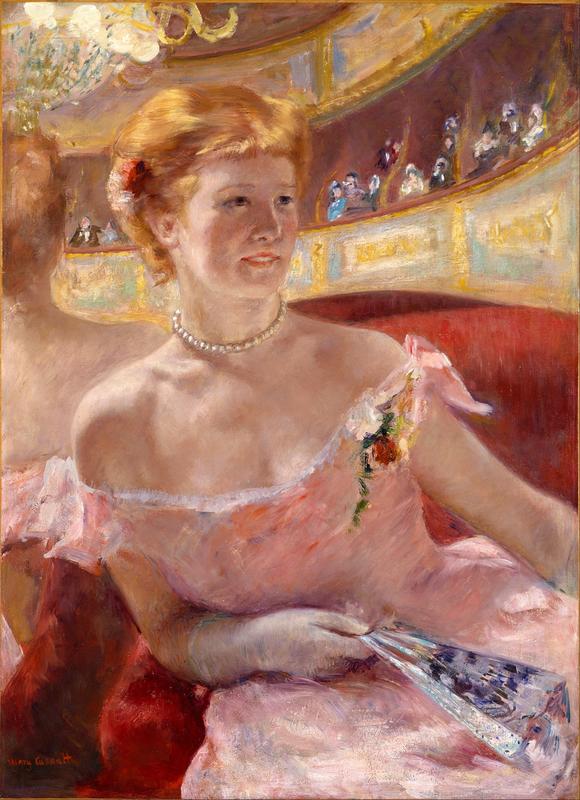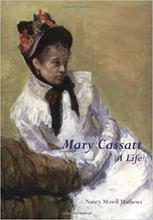More about Woman with a Pearl Necklace in a Loge
- All
- Info
- Shop

Sr. Contributor
Mary Cassatt was the only American painter who was officially accepted as an Impressionist.
Although she made art with some of the best, she was always, nevertheless, still an American. This is why you have to trek all the way to the American Wing when you want to see her works at the Met. This used to annoy me, mostly because it feels like she’s a mile away from the galleries that showcase the Impressionists, but then I realized how badass this is. To be one of the only women to actively participate in the group is one thing – shout out to Berthe Morisot, the other leading Impressionist lady – but to be the only American to make it into this exclusive group? Now that’s cool.
Although she was born and raised in what is now Pittsburgh and lived and studied in Philadelphia, Cassatt was an expatriate, taking up residence in Paris multiple times throughout her life. She even studied under the celebrated French artist Jean-Léon Gérôme, which caused her to paint in the terribly boring academic style for which he is known. Thankfully, a friendship with Degas showed her the way.
Hanging out with Degas influenced Cassatt’s work for the rest of her life. She absorbed their visible brushstrokes and love for modern, urban life, especially scenes of the Paris Opera. Degas and Renoir also painted women seated in loges, or opera balcony boxes. But, as a savvy modern woman, Cassatt did them one better. She focused on the subject of the modern woman, an issue she always remained aware of because of her own femininity and therefore knew the burden of her own gender all too well. Despite her successful painting career, she could not travel without a male companion. It’s telling that she paints a woman, who by the way might be her sister Lydia, alone, with men only shown seated in the balconies around her. Realizing his friend’s potential, Degas invited Cassatt to show her work in the fourth Impressionist Exhibition in 1879, where she exhibited this painting and won over the Parisian Salon crowd.
This was perhaps where Alexis Rouart first saw this painting, which he is said to have later acquired from Cassatt herself. It’s safe to say Rouart knew his stuff. He was the brother of Henri Rouart, who had a famous art collection including French greats such as Delacroix, Degas, Millet, and Corot.
After the Rouarts, the painting eventually made its way to America and into the hands of Charlotte Dorrance Wright, one of the heirs to the Campbell Soup fortune. The invention of delicious chicken noodle soup provided Mrs. Wright with hundreds of millions of dollars to buy great art. When she died in 1977, she donated this and many other works to the Philadelphia Museum of Art. This was a homecoming for Cassatt’s work but also a big deal for the museum. The 1978 bequest gave the museum a treasure trove of European paintings, including works by Fantin-Latour, the museum’s first Gauguin, three works by Pissarro, and a Sisley. Who knew soup could bring so much goodness to the world?
Sources
- Davies, Penelope J.E., Frima Fox Hofrichter, Joseph Jacobs, Ann M. Roberts, and David L. Simon. Janson’s Basic History of Western Art. 8th edition. Upper Saddle River, NJ: Pearson Education, Inc., 2009.
- Musee Delacroix. “Alexis Rouart.” Biographies. http://www.musee-delacroix.fr/en/activities-events/glossary/alexis-roua…. Accessed January 22, 2018.
- Philadelphia Museum of Art.“The Charlotte Dorrance Wright Collection.” Exhibitions. http://www.philamuseum.org/exhibitions/1979/697.html. Accessed January 22, 2018.
- Philadelphia Museum of Art. “Woman with a Pearl Necklace in a Loge.” Collections. https://www.philamuseum.org/collections/permanent/72182.html. Accessed January 22, 2018.
- The New York Times Archives. “Charlotte Dorrance Wright, at 65, Heiress to Campbell Soup Fortune.” The New York Times. Oct. 6, 1977. http://www.nytimes.com/1977/10/06/archives/charlotte-dorrance-wright-at…. Accessed
- Weinberg, Barbara H. “Mary Stevenson Cassatt (1844–1926).” The Heilbrunn Timeline of Art History. The Metropolitan Museum of Art. October 2004. https://www.metmuseum.org/toah/hd/cast/hd_cast.htm. Accessed January 22, 2018.
Featured Content
Here is what Wikipedia says about Woman with a Pearl Necklace in a Loge
Woman with a Pearl Necklace in a Loge (or Lydia in a Loge) is an 1879 painting by American artist Mary Cassatt.
The Philadelphia Museum of Art acquired the painting in 1978 from the bequest of Charlotte Dorrance Wright. The style in which it was painted and the depiction of shifting light and color was influenced by Impressionism. This painting shows a view of the modern woman and is similar in style to Degas.
Check out the full Wikipedia article about Woman with a Pearl Necklace in a Loge














In her painting, Woman with a Pearl Neclace in a Loge, Mary Cassatt portrays a stunning combination of color, texture, and shape. The woman’s bright hair in provides a striking dissonance with the crimson of her seat and the different brushstrokes of color on her dress as well as the gold reflected in the background and gives the piece depth while still holding it together. The minute details like the flowers in her hair and on her dress draw the eye to the background and pulls the eye forward. The contrast of color and the splendor of the background in gold brings the eyes to her neck and chest and ultimately the simple pearl necklace. It provides an interesting contrast that the woman is wearing such a simple necklace when the reflection shows the ostentatious nature of the rest of the room. The woman in the painting also sits with her back against a mirror which gave Cassatt the opportunity to play with the way that she portrayed the boxes and people. The blurred lines and intricate details that are just slightly out of focus bring more attention to the woman instead of distracting from her.